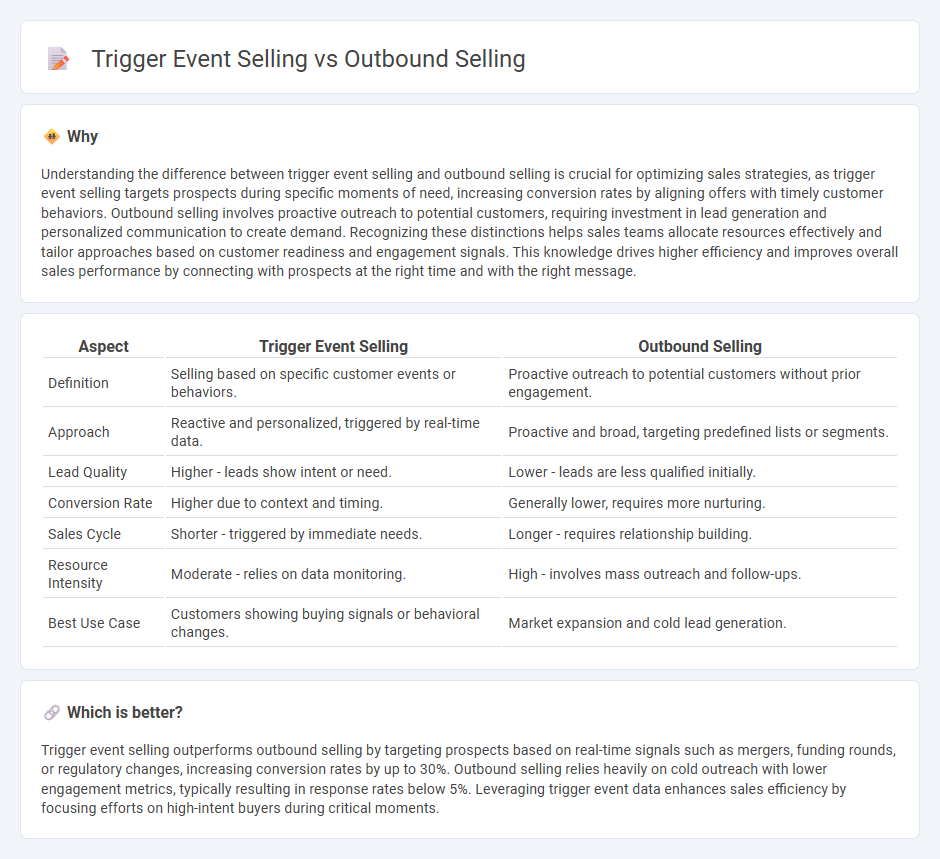
Trigger event selling leverages specific, timely occurrences like mergers, product launches, or leadership changes to identify high-potential sales opportunities, ensuring outreach aligns with a prospect's immediate business needs. Outbound selling typically involves proactive outreach through cold calls, emails, or social campaigns targeting predefined buyer personas regardless of current events. Explore deeper insights to understand how combining both strategies can maximize sales effectiveness.
Why it is important
Understanding the difference between trigger event selling and outbound selling is crucial for optimizing sales strategies, as trigger event selling targets prospects during specific moments of need, increasing conversion rates by aligning offers with timely customer behaviors. Outbound selling involves proactive outreach to potential customers, requiring investment in lead generation and personalized communication to create demand. Recognizing these distinctions helps sales teams allocate resources effectively and tailor approaches based on customer readiness and engagement signals. This knowledge drives higher efficiency and improves overall sales performance by connecting with prospects at the right time and with the right message.
Comparison Table
| Aspect | Trigger Event Selling | Outbound Selling |
|---|---|---|
| Definition | Selling based on specific customer events or behaviors. | Proactive outreach to potential customers without prior engagement. |
| Approach | Reactive and personalized, triggered by real-time data. | Proactive and broad, targeting predefined lists or segments. |
| Lead Quality | Higher - leads show intent or need. | Lower - leads are less qualified initially. |
| Conversion Rate | Higher due to context and timing. | Generally lower, requires more nurturing. |
| Sales Cycle | Shorter - triggered by immediate needs. | Longer - requires relationship building. |
| Resource Intensity | Moderate - relies on data monitoring. | High - involves mass outreach and follow-ups. |
| Best Use Case | Customers showing buying signals or behavioral changes. | Market expansion and cold lead generation. |
Which is better?
Trigger event selling outperforms outbound selling by targeting prospects based on real-time signals such as mergers, funding rounds, or regulatory changes, increasing conversion rates by up to 30%. Outbound selling relies heavily on cold outreach with lower engagement metrics, typically resulting in response rates below 5%. Leveraging trigger event data enhances sales efficiency by focusing efforts on high-intent buyers during critical moments.
Connection
Trigger event selling and outbound selling are connected through their focus on timely and relevant customer engagement to drive sales opportunities. Trigger event selling leverages specific occurrences such as product launches, mergers, or market shifts to initiate targeted outbound campaigns that resonate with prospects' current needs. This alignment enhances the effectiveness of outbound selling by ensuring outreach is contextually relevant and increases conversion rates.
Key Terms
Outbound Selling:
Outbound selling relies on proactive outreach strategies, targeting potential customers through cold calls, emails, and social media to generate leads and drive sales. It emphasizes a structured approach to identifying and engaging prospects before they express interest, enabling businesses to control the sales pipeline actively. Explore more to understand how outbound selling can transform your revenue generation process.
Cold Calling
Outbound selling relies heavily on cold calling to initiate contact with potential customers who have not yet expressed interest, requiring persuasive communication and strong lead generation techniques. Trigger event selling, by contrast, leverages specific business events such as funding rounds or product launches to identify warm leads more receptive to outreach, significantly increasing conversion rates. Explore strategic approaches to cold calling in both models to optimize your sales efforts and improve results.
Prospecting
Outbound selling focuses on proactively reaching potential customers through cold calls, emails, and direct outreach to initiate sales conversations. Trigger event selling targets prospects who are experiencing specific business or personal events, such as mergers, funding, or leadership changes, signaling increased readiness to buy. Discover how aligning prospecting strategies with trigger events can enhance sales effectiveness.
Source and External Links
Outbound Sales: How To Create an Outbound Sales Strategy - Outbound sales is a proactive approach where sales reps initiate contact with prospects through cold calls, emails, social selling, and events to identify and close deals, commonly used in B2B and B2C contexts.
What is Outbound Sales? - Outbound sales describes a strategy where salespeople actively reach out via cold calling, cold emailing, and social selling to pitch products to prospects, enabling rapid customer base growth, especially in SaaS.
What is Outbound Sales? Strategies and Tips for Reps - Outbound sales offers fast, precise lead generation with real-time customer feedback and scalability, allowing businesses to target ideal customers and quickly adjust sales tactics.
 dowidth.com
dowidth.com